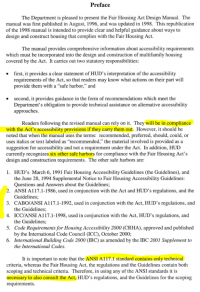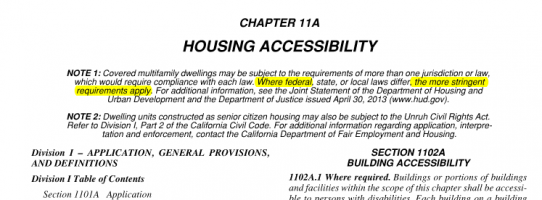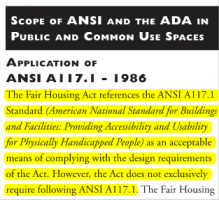Yeah, but that's where I'm still confused, too. (And I realize now we're getting off topic of the original post, but bear with me.)
As I understand it, FHADM is a standalone document. FHADM does not require a user to research ANSI 117.1 to see if the project complies with FHADM. See the copy of the Preface from FHADM below.
View attachment 7725
FHADM covers both technical AND scoping criteria and is thus a standalone safe harbor.
Here we see that ANSI 117.1 is listed in 3 of 6 alternative safe harbors for technical criteria, but it does not cover scoping, so it has to be taken in conjunction with the scoping in FHADM.
So, it's easier for us to just use the FHADM (+HUD +Guidelines) as a standalone, and not bother consulting ANSI 117.1.
More to the point, California's own CBC-11A was based on (and in several ways exceeds) FHADM, so during the building design process, most professionals out here tend to focus primarily on 11A in the effort of compliance with FHADM.
ADAguy is technically correct that FHADM (and ADA, for that matter) is not "code" in CA, in the sense that the state did not adopt FHADM as a code and does not require the authorities having local jurisdiction to plan check utilizing FHADM.
Instead, CA plan checks to CBC-11B code for public facilities, or CBC-11A code for private housing.
Having said that, there is a preamble "Note 1" at the very start of CBC 11A, that helpfully reminds everyone to comply with the most stringent requirements of "
more than one jurisdiction" either federal, state, or local laws, and it makes specific reference to a
HUD/DOJ statement dated 4/30/13. That letter is all about the scoping applicability of federal FHA to private housing. See image below.
Conclusion: it is semantically correct to say that FHADM is not "code" enforced by the jurisdiction of California building departments, but is is still a "requirement" that is enforced by the federal government via post-construction civil litigation, and woe to the person who forgets this.
View attachment 7724



